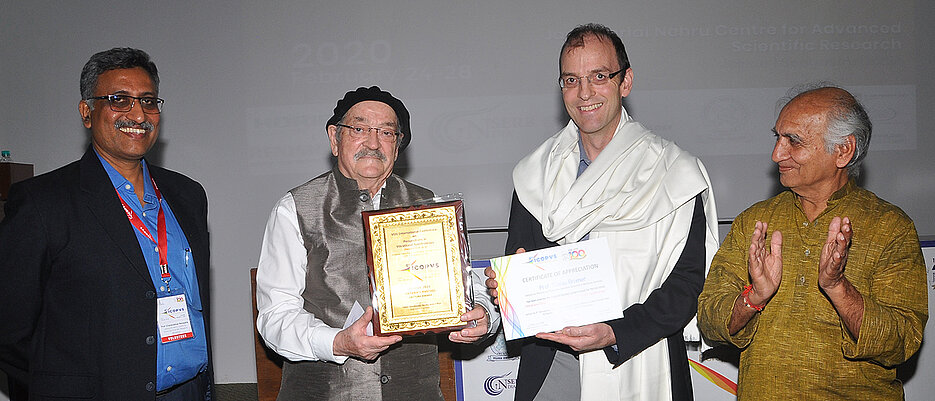Award for Tobias Brixner
10.03.2020His work provides detailed insights into the ultrafast dynamics of excited molecules. The Würzburg physicist and physicochemist, Tobias Brixner, recently received the "Dayawati Rastogi Lecture Award" in India for his achievements in this field.

Sir Chandrasekhara Venkata Raman is probably India's most famous natural scientist. His discovery of the Raman effect, named after him, announced on 28 February 1928 revolutionised the field of material analysis. In 1930, Raman was awarded the Nobel Prize in Physics. To mark this major discovery, 28 February was designated as National Science Day and has been celebrated all over India each year since 1987. Even today, almost a hundred years after the discovery, this spectroscopic method is an indispensable standard in every physical, chemical, materials science and pharmaceutical laboratory.
The underlying principle: When light at a given frequency is incident on matter, some of the light is scattered back at a different frequency. This difference in frequencies, the so-called "Raman scattering", provides information on the vibrations and thus on the composition of the material. In addition to basic science, Raman spectroscopy is used in many present-day applications, such as material analysis and quality control of pharmaceutical drugs and food.
Simple setup, fast results
The working group of Tobias Brixner from the Institute of Physical and Theoretical Chemistry at the University of Würzburg has now extended the variant of the so-called resonance Raman spectroscopy to three frequency axes and provided it with a particularly sensitive fluorescence detection. Their development provides detailed insights into the excited states of molecules and their ultrafast dynamics. "What's special about our development is the simple design of the experimental setup. Unlike established methods, it requires just one single laser beam and no mechanical moving parts, enabling very fast data acquisition," Brixner explains.
Brixner presented the results of his work at the eighth "International Conference on Perspectives in Vibrational Spectroscopy" (ICOPVS) which took place from 24 to 29 February 2020 at the "Jawaharlal Nehru Centre for Advanced Scientific Research" in Bangalore, the country's IT hub, also known as the "Silicon Valley of India". On the National Day of Science, Brixner was awarded the "Dayawati Rastogi Lecture Award" at the conference sponsored by the "Indian Spectroscopy Society" and the "Asian Journal of Physics".
High practical relevance
Wolfgang Kiefer, emeritus professor of the University of Würzburg and former editor of the "Journal of Raman Spectroscopy", is an acknowledged pioneer and an expert in Raman spectroscopy of worldwide renown. Having been to India for the 30th time already in his role as the honorary chairman of the ICOPVS conference series, he comments: "Raman spectroscopy is of great practical significance and can be used, among others, to detect viruses and diseases, a topic that is highly relevant given the current coronavirus outbreak. New technical developments are driving these and other fields of application."
Contact
Prof. Dr. Tobias Brixner
Department of Physical Chemistry I
T.: +49 931 31-86330, brixner@uni-wuerzburg.de






